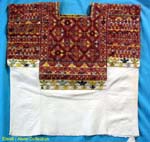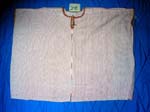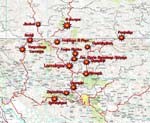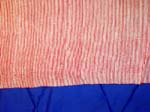.jpg) |
.jpg) |
 |
 |
 |
 |
 |
 |
| When we were visiting San Andres, we asked how to get to Magdalenas, the famous weaving village, which is located a short distance away. This question drew blank stares. We learned that this is because everybody (except textile collectors) refer to this community as Aldama. Its true name is Santa Maria Magdalena Aldama. We drove there in April 2003 over a rough unpaved road. When we returned in 2005, this road was somewhat rerouted and paved. Despite the paved road, this small town is little-visited by outsiders. No one offered to kill us, as in San Andres, but no one rolled out the welcome mat either. We had been given the name of an expert weaver and sought her out to purchase textiles. We found her family compound and were led into the family’s drinking establishment (in Ecuador they’d call it a "salon"). The women were delighted to see us, and even happier when we told them we wanted to buy a huipil. They called the expert weaver, who appeared carrying a magnificent, full-length, wool ceremonial huipil that had taken her 2 years to weave. Everyone thought we had come to buy it. It was a bargain at $700, but beyond our price range. Faces fell when we said that we wanted to buy an example of the day-to-day huipil. One of the women went out back and took one off the clothesline. It was still damp from recent washing. We loaded up on woven servilletas to lessen the guilt we felt at disappointing the family. The daily use huipil is a pink (or white) two-web huipil, It has a small area of embroidery at the neckline and other small brocaded areas on the body of the huipil. It is worn with a blue or black skirt which is pleated in a way that makes it appear fuller than the skirts of other towns. Some skirts also have several narrow, white horizontal stripes. The famous three-web ceremonial huipil is usually woven of wool, not cotton, and is densely brocaded with symbolic designs. Anyone interested in this garment must read Chip Morris’s magnificent book “Living Maya” which highlights this huipil. Aldama women also wear layers of red beads around their necks, which makes them immediately recognizable. We purchased a second Aldama daily huipil in San Andres in 2005. The decorated areas are significantly larger on the 2005 huipil than on the 2003 huipil. This reflects a general trend in Chiapas clothing. The embroidery or brocade becomes more dense and ornate and covers a larger area of the garment. Only elderly men wear traditional attire. Men’s ceremonial costumes consist of a white tunics over white shirts and short pants. White shoulder cloths are worn around the shoulders like capes. Ceremonial sashes have wide areas of dense brocade at their ends. |
|
Home - The Collection - Favorite Photos- Bob's Top 10 - Textile Patterns - The Villages - Participate
For more information or comments please contact me at: info@mexicantextiles.com © 2005 Bob Freund All Rights Reserved |